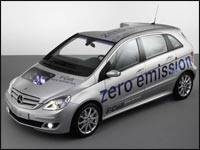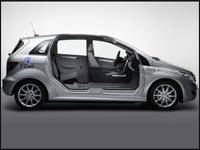The first time I rode -- or at least was scheduled to ride -- in a Daimler-Benz fuel cell vehicle, the fuel cell itself was about as big as the most recent alternative-fuel vehicle from the company, the F-Cell.
About a decade ago, dozens of auto writers from all around the world went to Germany for a chance to ride in the Necar 1 on a six-minute journey around the Brandenburg Gates.
The Necar 1 was the size of a delivery van, and it only made two or three loops around the centre of Germany's capital before it started malfunctioning. When it never returned from the seventh lap, about 100 of us had to go home without experiencing the vehicle even second-hand. We were all told the problem did not involve the fuel cell, and it was apparently true.
In those days, the promise of fuel cells as a future source of motive power was strong, but still pretty much a dream. Now that F-Cell is going on the road for tests, it's still pretty much a dream, but the future of fuel cells seems stronger.
This time, DaimlerChrysler's test vehicle is essentially a production car with the fuel cell tucked carefully inside, and that development alone speaks volumes about how the technology has changed.
The new F-Cell, built on the Mercedes-Benz B-Class, is extending the family of fuel cell vehicles to the segment of mini-minivans, or what DCX likes to call sports-tourers.
The clever bit involves tucking bits of the fuel cell gear into the floor underneath passenger compartment, in what the Stuttgart firm call the ''sandwich concept'' that ''makes it predestined for this type of drive unit.''
According to DCX, ''sporty, dynamic driving is reconcilable with emission-free operation'' in the F-Cell, as is ''impressively demonstrated by the technical data -- the high-torque electric motor will develop more than 100 kW, which is 35 kW more power than the previous generation.
Just as importantly, by reducing the fuel consumption and further enhancing the storage capacity, the operating range of the latest fuel cell vehicle gone to almost 400 km. On top of that, the component reliability and longevity are also said to have been improved.
''With this car, we are continuing our highly successful practical tests on an even larger scale," says Dr. Thomas Weber, member of DaimlerChrysler's board of management with responsibility for research and technology and for the development of the Mercedes Car Group.
Daimler-Benz researchers and engineers started working on since 1990 toward automotive application of this technology. Since NECAR 1 in 1994, more than 20 other research vehicles and prototypes have since followed, now under the DaimlerChrysler banner.
As my story about the Berlin program suggests, the size and weight of the drive system have been considerably reduced, while the performance and reliability have been steadily enhanced.
Close to 200 patent applications in the field of fuel cell technology underscore the pioneering achievements of DaimlerChrysler, says Weber. ''With the Mercedes-Benz B-Class F-Cell, a further significant milestone has been reached along the road to market maturity for the fuel cell.''
About a decade ago, dozens of auto writers from all around the world went to Germany for a chance to ride in the Necar 1 on a six-minute journey around the Brandenburg Gates.
The Necar 1 was the size of a delivery van, and it only made two or three loops around the centre of Germany's capital before it started malfunctioning. When it never returned from the seventh lap, about 100 of us had to go home without experiencing the vehicle even second-hand. We were all told the problem did not involve the fuel cell, and it was apparently true.
In those days, the promise of fuel cells as a future source of motive power was strong, but still pretty much a dream. Now that F-Cell is going on the road for tests, it's still pretty much a dream, but the future of fuel cells seems stronger.
This time, DaimlerChrysler's test vehicle is essentially a production car with the fuel cell tucked carefully inside, and that development alone speaks volumes about how the technology has changed.
 |
| Mercedes-Benz B-Class F-Cell (photo: DaimlerChrysler AG) |
The clever bit involves tucking bits of the fuel cell gear into the floor underneath passenger compartment, in what the Stuttgart firm call the ''sandwich concept'' that ''makes it predestined for this type of drive unit.''
According to DCX, ''sporty, dynamic driving is reconcilable with emission-free operation'' in the F-Cell, as is ''impressively demonstrated by the technical data -- the high-torque electric motor will develop more than 100 kW, which is 35 kW more power than the previous generation.
Just as importantly, by reducing the fuel consumption and further enhancing the storage capacity, the operating range of the latest fuel cell vehicle gone to almost 400 km. On top of that, the component reliability and longevity are also said to have been improved.
 |
| Mercedes-Benz B-Class F-Cell (photo: DaimlerChrysler AG) |
Daimler-Benz researchers and engineers started working on since 1990 toward automotive application of this technology. Since NECAR 1 in 1994, more than 20 other research vehicles and prototypes have since followed, now under the DaimlerChrysler banner.
As my story about the Berlin program suggests, the size and weight of the drive system have been considerably reduced, while the performance and reliability have been steadily enhanced.
Close to 200 patent applications in the field of fuel cell technology underscore the pioneering achievements of DaimlerChrysler, says Weber. ''With the Mercedes-Benz B-Class F-Cell, a further significant milestone has been reached along the road to market maturity for the fuel cell.''

